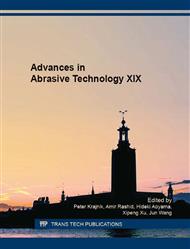p.34
p.40
p.46
p.52
p.59
p.64
p.70
p.79
p.85
Development of a PCD Burnishing Tool and its Burnishing Performance
Abstract:
In this study, a polycrystalline composite diamond (PCD) was adopted instead of a single crystal diamond as a burnishing tool. At first, EDM machinability was compared between two kinds of PCDs (10μm grain size), i.e. standard PCD (S-PCD) and electrically conductive PCD (EC-PCD (which was made of boron doped diamond particles). EDM machining time to make a hemispherical shape was 17 minutes for EC-PCD and 37 minutes for S-PCD. Further experiments were conducted with EC-PCD of different grain sizes such as 2μm and 5μm. As a result, the smaller the grain size of EC-PCD the higher the machining efficiency was. Surface roughness values of the EC-PCD after finish EDM were Rz=1.7μm for EC-PCD010, Rz=1.4μm for EC-PCD005, and Rz=1.2μm for EC-PCD002. As a result of burnishing a carbon steel bar (S45C, φ30mm) with the EC-PCD tool, the surface roughness value after machining was improved from 10μm to 1μm.
Info:
Periodical:
Pages:
59-63
Citation:
Online since:
October 2016
Authors:
Price:
Сopyright:
© 2016 Trans Tech Publications Ltd. All Rights Reserved
Share:
Citation:


